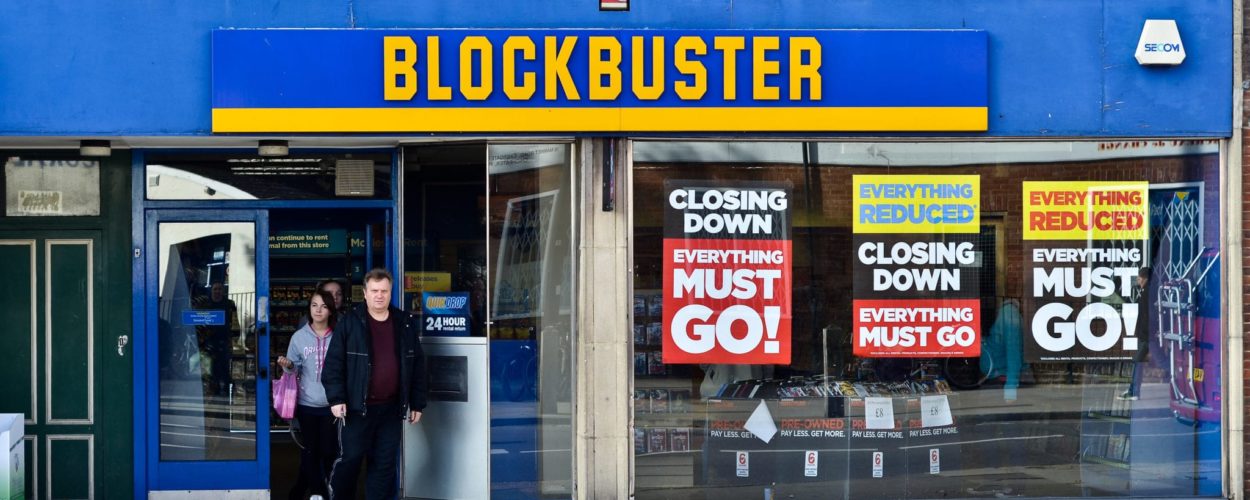
They say the dead don’t tell tales, however, that is clearly not the case in the business world, as 429 of the 500 most successful companies of the past 60 years no longer exist today. As the first of a three-part series, where we will look at some of the biggest enterprise disasters (and one of the most epic rebirths), we bring you the video rental king that was, Blockbuster.
Join us as we study Blockbuster, the one time enterprise giant, and learn about what exactly went wrong.
The Cause of Death
Perhaps the most glaring example of a lack of innovation and inability to keep up with the times is Blockbuster, but the reality is that in this case, a lack of innovation is not what ‘did them in.’
Founded in 1985, Blockbuster came into the market as the undisputed video rental king. In 1999, Viacom, who purchased the company in 1994, offered 18% to the public for $465 million in an IPO that made headlines. Within a short period of time, the movie rental giant had strong market share and intense customer loyalty, making Blockbuster a household name across America and the rest of the world.

At the same time, Reed Hastings had a crazy idea and decided to start shipping DVD’s directly to consumers’ homes with the launch of his small company called Netflix. Compared to Blockbuster, Netflix had little overhead costs due to not having a physical location and offered consumers a late-fee-free alternative. As consumers warmed up to the idea of ordering movies online and having them delivered to their doors, the company quickly took off and Blockbuster could not keep up.
After fighting ferociously to keep up, Blockbuster received a merger offer from Netflix CEO, Hastings, but rejected the offer in a mistake that many claim would have been Blockbusters’ saving grace.
So how did Blockbuster go from being a mega enterprise to a thing of the past? Business analysts and executives agree that Blockbuster simply forgot who they were and what they set out to do in the first place. Their lack of a digital presence was not slowing them down at the time and a merger with Netflix might not have saved them- at the height of the Netflix rivalry, Blockbuster brought in a new CEO who was out of touch with the actual value the company offered its consumers. Instead of focusing on the entertainment value and up-selling the titles based on individual customer preferences, Blockbuster made a conscious move to up the ‘basket’ price of each sale and began offering a convenience-store-like buffet of candy and toys at the cash register to increase the value of the sale.
At the end of the day, the success Netflix achieved was not on the back of Blockbuster – they merely filled the void that Blockbuster at a time did fill. The disconnect between what Blockbuster offered and what consumers wanted is ultimately what killed the undisputed movie-store star.
Lesson Learned for Enterprises
The case of Blockbuster is, at its core, a case of lack of strategy. The need to innovate does not refer solely to technology (although if Blockbuster came up with the Netflix concept alone, they might have not met their demise), but in the ability of a company to be innovative as a culture. When the new management came into Blockbuster, they brought in a corporate culture and value system that was not in line with the existing (successful) brand, or its customers’ expectations.
To retain market share and power, realize the need to uphold brand identity and values Click To TweetUltimately, Blockbuster should have focused on retail experience, and could have positioned themselves in a way that was more in line with the new needs and expectations of their movie-watching clientele. Instead, Blockbuster tried to take down a competitor with a superior technology and did not invest in developing their own solution or retaining their clients and upholding their satisfaction. As companies look to retain market share and power, they need to first realize that they need to uphold their brand identity and values. They need to understand what made them strong in the first place, or else risk losing everything to the new kid on the Block.